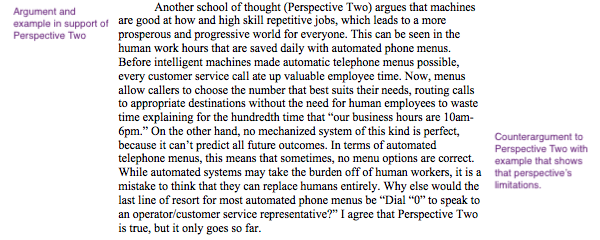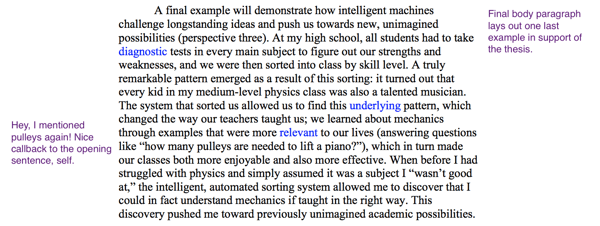A Common Mistake When Writing A Reflective Essay Is To
There is no part of the ACT more mysterious to students than the essay, and very few people seem to know what exactly the ACT is looking for in a "perfect" essay (particularly since September 2015 was the new ACT Writing test's debut). Luckily, we've got the expertise to give you some insight into how the essay works and what you can do to push your score those extra few points up the scale. Whether you're trying to impress your dream school or just want to boost your ACT score, the essay is a great thing to work on. Some of the tips below stand alone, while others are part of larger categories that have been assembled based our ACT expertise. Important: If you haven't read these two other ACT Writing guides before, take a minute and read them now: The ACT Writing Rubric: Analysis, Explanation, and Strategies How to Write an ACT Essay, Step by Step This will make the rest of the article make more sense. If you're already scoring an 8 or above in every domain on practice (or real) ACT essays, you have a shot at completely nailing what the graders want, represented by a score of 12, with a little practice. But there's something important to remember in your quest for perfection: on the ACT essay, a 12 is not always achievable. We've got good news and bad news for those of you who are determined to know how to get a 12 on the ACT essay. You'll have to practice this specific essay. The perfect ACT essay is like a puzzle that happens to be in writing form—it can be mastered, but to do it well and completely every time requires a few month's practice. Knowing how to write other kinds of essays will only help you a limited amount. Because the whole essay must be written in 40 minutes, getting a 12 requires some luck. You have to pick a thesis and think of relevant and convincing evidence to support it before you can even start writing, so a lot depends on how quickly you can decided on a point of view and relevant support for whatever the prompt happens to be. And because perfect-scoring essays are almost always at least two pages long, you won't have any time to spare. Because the essay is so formulaic, it's always possible to get at least a 10 in each domain. And, on top of this, no college worth its salt is going to base your college admission on getting those last two points on an essay you had to write in 40 minutes. The goal, really, is to show that you can write a decent essay in that time, and a 10 in each domain shows that just as well as a 12 does. If we asked the ACT what the difference is between a 10 and a 12 ACT essay, they would direct us to their scoring criteria (replicated in the table below) that describes the difference between the 5 and 6 essay scores in each domain. As you may already know, a total domain score of 12 comes from two readers separately giving your essay a 6; the four domain scores are then averaged to calculate your total essay score of 12. We've marked the differences between the 5 and 6 criteria in bold. Later, we'll look at these differences in the context of a sample essay. The 6 essay gives a more specific and logically precise context. The thesis and argument show a deep understanding of the issue, while the analysis not only mentions, but also inspects the complexities and implications of the issue. Now we'll look at a sample essay and how it demonstrates the characteristics of the 6 essay above. First, let's look at the prompt: Intelligent Machines Many of the goods and services we depend on daily are now supplied by intelligent, automated machines rather than human beings. Robots build cars and other goods on assembly lines, where once there were human workers. Many of our phone conversations are now conducted not with people but with sophisticated technologies. We can now buy goods at a variety of stores without the help of a human cashier. Automation is generally seen as a sign of progress, but what is lost when we replace humans with machines? Given the accelerating variety and prevalence of intelligent machines, it is worth examining the implications and meaning of their presence in our lives. Perspective One: What we lose with the replacement of people by machines is some part of our own humanity. Even our mundane daily encounters no longer require from us basic courtesy, respect, and tolerance for other people. Perspective Two: Machines are good at low-skill, repetitive jobs, and at high-speed, extremely precise jobs. In both cases they work better than humans. This efficiency leads to a more prosperous and progressive world for everyone. Perspective Three: Intelligent machines challenge our long-standing ideas about what humans are or can be. This is good because it pushes both humans and machines toward new, unimagined possibilities. Write a unified, coherent essay about the increasing presence of intelligent machines. Now, read the ACT essay example below, and try to notice how it meets the criteria in the table above. From the simplest system of pulleys and ropes to the most complex supercomputer in the world today, machines have had (and continue to have) a profound influence on the development of humanity. Whether it is taking over monotonous, low-skill tasks or removing that messy "human" element from our day-to-day interactions, machines have answered the call to duty. The increasing prevalence of intelligent machines challenges us to change long held beliefs about our limitations and to continue forward to new and even more advanced possibilities. This was a real essay written by me within the time limit. What do you think? Now let's look at an annotated version of this ACT essay example that points out the essay's features. > The author clearly states her perspective and compares it to two other given perspectives, presenting both positive and negative aspects of the two perspectives she does not entirely agree with: "One common argument against the increased presence of machines in our day to day lives is that machines leach from us our basic humanity...Yet machines are also capable of enhancing people's abilities to communicate." > The author gives both general statements... " Rather than losing part of our own humanity to machines, we instead make that most-essential-to-humanity of acts, communication, possible." > ...and specific examples that discuss both sides of the perspectives: "...certain people whose only social interactions are anonymous text-based conversations with other anonymous Internet forum dwellers over computers may begin to lose basic human courtesy and empathy...[on the other hand,] breakthroughs in neurotechnology have made it possible for quadripalegics to manipulate text on computers with their minds." > The essay begins (after the introduction paragraph) by addressing opposing views and discussing their strengths and their limits. > Then it goes on in paragraphs 4 to explain a final reason why intelligent machines challenge ideas about humanity and push us towards new possibilities. > The "advanced" vocabulary is highlighted in blue. > Sentence structure is varied, like here: "On the other hand, no mechanized system of this kind is perfect, because it can't predict all future outcomes. In terms of automated telephone menus, this means that sometimes, no menu options are correct. While automated systems may take the burden off of human workers, it is a mistake to think that they can replace humans entirely. Why else would the last line of resort for most automated phone menus be "Dial "0" to speak to an operator/customer service representative?"" The essay is long enough to analyze and compare the author's perspective to other perspectives in a nuanced way (one positive example for each perspective with an addition negative example comparing two perspectives the author disagreed with to her own perspective) and include an introductory paragraph and a conclusion. While ACT, Inc. doesn't acknowledge that length is a factor in scoring ACT essays, most experts agree that it is. But length means nothing if there isn't valuable information filling the space, so long ACT essays also need to be detailed—this author uses the space to give lots of analysis of and context for her examples. You may have noticed that the essay is broken up into multiple paragraphs (into the standard five-paragraph format, in fact). This makes the essay easier to read, especially for the ACT readers who have about two to three minutes to read (and score!) each essay. If your points can easily be split up into small parts, then it makes sense to split it up into even more paragraphs, as long as your essay's organization and logical progression remains clear. This essay uses a personal example, which may or may not be made up (spoiler alert: it is). But the point is that it could be made up, as can anything you use in your essay. Being able to think of examples (that are not too obviously made up) can give you a huge advantage on the ACT essay. The key to a perfect score on the ACT essay is to use every second of your time wisely. To this end, here are a few tips to avoid common time-wasters and put your energy where it will get you the most points. #1: Writing as much as you can without including repetitive or irrelevant information. #2: Revising the first and last paragraphs (they stand out in readers' minds). #3: Making sure you have transitions. #1: Thinking of 'smart' sounding evidence— examples from your own life (or made up about your own life) are just as viable as current events, as long as you keep your example focused and concise. #2: Trying to correct every error—the grammar and spelling do not have to be perfect to score a 12 in the Language Use domain. #3: Adding as many vocabulary words as you can—you only need enough to avoid repeating the same basic words or phrases multiple times; you'll max out fancy vocab's potential at two words per paragraph. Find out more about how to write an ACT essay with this step-by-step example. Use our analysis of the ACT Writing Rubric to learn about how your essay will be scored—and discover strategies you can use to get the score you want. Want to aim for perfection on the ACT with a 36? Read our guide on how to score a perfect ACT score, written by our resident 36 scorer. Make sure your ACT score is high enough for the schools you want to apply to. Find out how to find your ACT target score. Want to improve your ACT score by 4 points? Check out our best-in-class online ACT prep classes. We guarantee your money back if you don't improve your ACT score by 4 points or more. Our classes are entirely online, and they're taught by ACT experts. If you liked this article, you'll love our classes. Along with expert-led classes, you'll get personalized homework with thousands of practice problems organized by individual skills so you learn most effectively. We'll also give you a step-by-step, custom program to follow so you'll never be confused about what to study next. Try it risk-free today: 
Part I: What a 12 on the ACT Essay Means

The Big Secret
The Bad News
The Good News
Part II: The Difference Between a 10 and a 12
Score of 5 (10) Score of 6 (12) Major Differences Responses at this scorepoint demonstrate well-developed skill in writing an argumentative essay. Responses at this scorepoint demonstrate effective skill in writing an argumentative essay. Ideas and Analysis
The writer generates an argument that productively engages with multiple perspectives on the given issue. The argument's thesis reflects precision in thought and purpose. The argument establishes and employs a thoughtful context for analysis of the issue and its perspectives. The analysis addresses implications, complexities and tensions, and/or underlying values and assumptions. The writer generates an argument that critically engages with multiple perspectives on the given issue. The argument's thesis reflects nuance and precision in thought and purpose. The argument establishes and employs an insightful context for analysis of the issue and its perspectives. The analysis examines implications, complexities and tensions, and/or underlying values and assumptions. Development and Support Development of ideas and support for claims deepen understanding. A mostly integrated line of purposeful reasoning and illustration capably conveys the significance of the argument. Qualifications and complications enrich ideas and analysis. Development of ideas and support for claims deepen insight and broaden context. An integrated line of skillful reasoning and illustration effectively conveys the significance of the argument. Qualifications and complications enrich and bolster ideas and analysis. The 6 essays develops its ideas and support for those ideas more thoroughly and examines the implications of the ideas and support in a larger context. In addition, the complexity of the discussion for each examples strengthens the essay's argument and the analysis of the issue at hand.
Organization The response exhibits a productive organizational strategy. The response is mostly unified by a controlling idea or purpose, and a logical sequencing of ideas contributes to the effectiveness of the argument. Transitions between and within paragraphs consistently clarify the relationships among ideas. The response exhibits a skillful organizational strategy. The response is unified by a controlling idea or purpose, and a logical progression of ideas increases the effectiveness of the writer's argument. Transitions between and within paragraphs strengthen the relationships among ideas. The 6 essay is organized to enhance the logic and strength of the writer's argument, whereas the 5 essay is only organized clearly. Language Use
The use of language works in service of the argument. Word choice is precise. Sentence structures are clear and varied often. Stylistic and register choices, including voice and tone, are purposeful and productive. While minor errors in grammar, usage, and mechanics may be present, they do not impede understanding. The use of language enhances the argument. Word choice is skillful and precise. Sentence structures are consistently varied and clear. Stylistic and register choices, including voice and tone, are strategic and effective. While a few minor errors in grammar, usage, and mechanics may be present, they do not impede understanding. The 6 essay is written extremely well, whereas the 5 essay is written pretty well. This means getting creative and using advanced vocabulary appropriately if you want a 6. Part III: Applying the Criteria in a Real ACT Essay Example
One common argument against the increased presence of machines in our day to day lives is that machines leach from us our basic humanity. Indeed, certain people whose only social interactions are anonymous text-based conversations with other anonymous Internet forum dwellers over computers may begin to lose basic human courtesy and empathy. This is crystal clear with a glance at the comments section of any popular news article. Yet machines are also capable of enhancing people's abilities to communicate. An example of this can be found in Tod Machover's lab at MIT, where breakthroughs in neurotechnology have made it possible for quadripalegics to manipulate text on computers with their minds. Such interactions would be impossible without the existence of intelligent machines. Therefore, I must disagree with Perspective one. Rather than losing part of our own humanity to machines, we instead make that most-essential-to-humanity of acts, communication, possible.
Another school of thought (Perspective Two) argues that machines are good at how and high skill repetitive jobs, which leads to a more prosperous and progressive world for everyone. This can be seen in the human work hours that are saved daily with automated phone menus. Before intelligent machines made automatic telephone menus possible, every customer service call ate up valuable employee time. Now, menus allow callers to choose the number that best suits their needs, routing calls to appropriate destinations without the need for human employees to waste time explaining for the hundredth time that "our business hours are 10am-6pm." On the other hand, no mechanized system of this kind is perfect, because it can't predict all future outcomes. In terms of automated telephone menus, this means that sometimes, no menu options are correct. While automated systems may take the burden off of human workers, it is a mistake to think that they can replace humans entirely. Why else would the last line of resort for most automated phone menus be "Dial "0" to speak to an operator/customer service representative?" Perspective Two is true, but it only goes so far.
A final example will demonstrate how intelligent machines challenge longstanding ideas and push us towards new, unimagined possibilities (perspective three). At my high school, all students had to take diagnostic tests in every main subject to figure out our strengths and weaknesses, and we were then sorted into class by skill level. A truly remarkable pattern emerged as a result of this sorting: it turned out that every kid in my medium-level physics class was also a talented musician. The system that sorted us allowed us to find this underlying pattern, which changed the way our teachers taught us; we learned about mechanics through examples that were more relevant to our lives (answering questions like "how many pulleys are needed to lift a piano?"), which in turn made our classes both more enjoyable and also more effective. When before I had struggled with physics and simply assumed it was a subject I "wasn't good at," the intelligent, automated sorting system allowed me to discover that I could in fact understand mechanics if taught in the right way. This discovery pushed me toward previously unimagined academic possibilities.
In conclusion, intelligent machines help us to move forward as a species to greater heights. While machines can cause problems and may in some cases need human input to function optimally, it is how we react and adapt to the machines that is the real takeaway.




What Makes This ACT Essay a 12, Rather Than an 8 or 10?
Major Differences between a 5 and a 6 Essay (from table above) Sample Essay Ideas and Analysis
The 6 essay gives a more specific and logically precise context. The thesis and argument show a deep understanding of the issue, while the analysis not only mentions, but also inspects the complexities and implications of the issue. Development and Support The 6 essays develops its ideas and support for those ideas more thoroughly and examines the implications of the ideas and support in a larger context. In addition, the complexity of the discussion for each examples strengthens the essay's argument and the analysis of the issue at hand. Organization The 6 essay is organized to enhance the logic and strength of the writer's argument, whereas the 5 essay is only organized clearly. Language Use The 6 essay is written extremely well, whereas the 5 essay is written pretty well. This means getting creative and using advanced vocabulary appropriately if you want a 6. Considerations That Aren't Included in the ACT's Published Guidelines
Length
Paragraph Breaks
Content and Examples
Do's and Don'ts for a 12 ACT Essay
Do spend time:
Don't spend time:
How To Practice Your Writing To Get A Perfect 12 In Each Domain
What's Next?


About the Author
Laura graduated magna cum laude from Wellesley College with a BA in Music and Psychology, and earned a Master's degree in Composition from the Longy School of Music of Bard College. She scored 99 percentile scores on the SAT and GRE and loves advising students on how to excel in high school.
A Common Mistake When Writing A Reflective Essay Is To
Source: https://blog.prepscholar.com/how-to-get-a-perfect-12-on-the-act-writing-essay
Posted by: paigeprimsequiew.blogspot.com

0 Response to "A Common Mistake When Writing A Reflective Essay Is To"
Post a Comment